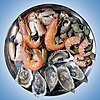
Seal meat is the flesh, including the blubber and organs, of seals used as food for humans or other animals. It is prepared in numerous ways, often being hung and dried before consumption. Historically, it has been eaten in many parts of the world.
Contents
Practice of seal consumption by humans continues today in Japan, Canada and Norway. [1]


